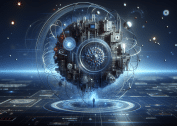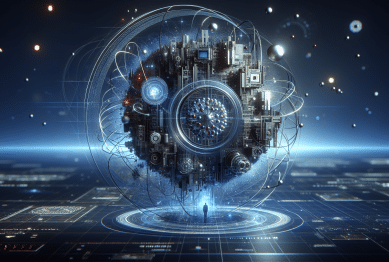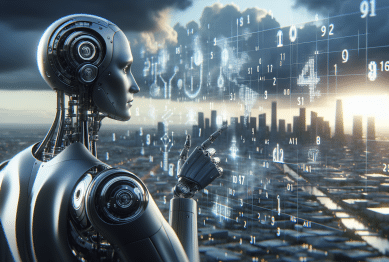Artificial intelligence has become part of daily life, shaping decisions big and small. This guide explores how AI learns, adapts, solves problems, and the ways it impacts society, privacy, and the future of work. Discover surprising insights about machine learning and its invisible role all around you.
What Artificial Intelligence Really Means
Artificial intelligence, or AI, refers to systems that can perform tasks usually requiring human intelligence. This includes language understanding, recognizing images, predicting trends, or even playing games. Popular AI tools often use large data sets and algorithms to find patterns and make predictions. Unlike traditional programming, AI systems learn from new information over time, improving accuracy and adapting to new situations without explicit rewrites. This ‘learning’ aspect is what sets AI apart and allows it to handle complex or unstructured data, like processing natural language or identifying patterns in noisy images.
The growth of AI applications spans almost every field. Healthcare uses AI to assist in diagnosing diseases. Finance relies on it for fraud detection. Transportation benefits from AI-powered systems that optimize logistics or drive autonomous vehicles. These advances are driven by machine learning models, which crunch massive datasets to spot relationships humans might overlook. As technology evolves, the boundary between what is “intelligent” for a machine and a human continues to blur. This convergence leads to new opportunities and questions about trust, control, and transparency in decision-making.
Importantly, not all AI is the same. Some systems, called narrow AI, are designed to solve a specific problem — like personal assistants or chatbots. Others, known as general AI, aim to replicate a broader set of human abilities but remain mostly theoretical. Narrow AI is everywhere in modern life, from recommending streaming shows to optimizing traffic. Understanding the range and depth of artificial intelligence is key to appreciating how far technology has already come and where it is likely headed.
How Machine Learning Makes AI Smarter
Machine learning is a core part of artificial intelligence. Rather than relying on hardcoded rules, machine learning involves teaching computers to recognize patterns through exposure to data. Algorithms process thousands or millions of examples, learning the connections between certain features and outcomes. This process is at the heart of facial recognition systems, search engines, voice assistants, and many other technologies used daily.
Machine learning models can be supervised, unsupervised, or semi-supervised. In supervised learning, systems receive labeled examples (“cat” or “not-cat”) and learn to identify new, unseen data. Unsupervised learning explores datasets for hidden patterns without prior labeling, a technique valuable in scientific research and market segmentation. Deep learning, a subfield, uses artificial neural networks inspired by the human brain to solve especially tough problems such as language translation or detecting abnormalities in medical scans.
AI systems adapt over time as they are exposed to more data or users provide feedback. This adaptability can make recommendations seem almost intuitive. However, no model is perfect. Machine learning systems can reflect biases in data or make unpredictable errors if not carefully trained and monitored. For this reason, transparency, validation, and ethical oversight are crucial in any industry deploying machine learning on a large scale (Source: https://www.nist.gov/artificial-intelligence).
Everyday Uses of Artificial Intelligence Around You
Most people interact with artificial intelligence several times each day, often without realizing it. Virtual assistants answer questions and schedule appointments. Email services identify spam using AI-powered filters. Maps and navigation apps rely on intelligent algorithms for real-time traffic updates and efficient route planning. Even the ads displayed during web browsing are optimized by learning algorithms tailored to user interests.
Social media relies heavily on machine learning. News feeds are curated by analyzing user activity and predicting which posts will generate the most interest. Image and video recognition enable automatic tagging of friends in photos. AI can moderate content, detect abusive language, and even identify misinformation campaigns with surprising accuracy. This broad adoption shapes the way people consume news and information.
Retail and entertainment industries use AI for personalized shopping experiences. Recommendation engines analyze shopping habits, browsing history, and reviews to suggest products or movies tailored to individual preferences. AI-driven features enhance everything from customer service chatbots to in-store inventory management, helping businesses respond faster and more accurately. These practical applications highlight how seamlessly AI has blended into daily routines (Source: https://ai.google/education/).
Data, Privacy, and AI Ethics
One of the biggest challenges with widespread artificial intelligence adoption is privacy. AI tools often require significant amounts of personal data to function effectively — from health records to voice samples and location history. The more data collected, the better the predictions can be. However, this raises questions about who has access to this information, how it is stored, and what happens to it after use.
Ethical concerns in AI extend to bias, fairness, and accountability. AI models may accidentally perpetuate historical inequalities if trained on unbalanced data sets. When algorithms make decisions about credit, employment, or legal outcomes, transparency becomes vital. Many regulatory frameworks, such as the European Union’s General Data Protection Regulation (GDPR), aim to protect individual rights and ensure fairness in algorithmic decision-making (Source: https://www.edps.europa.eu/data-protection/our-work/subjects/artificial-intelligence_en).
Companies and researchers strive to balance innovation in AI with privacy and ethics through better data anonymization, robust consent processes, and regular audits. Public awareness and government oversight keep these efforts accountable. As AI grows increasingly powerful, ongoing dialogue about transparency, control, and societal values will shape its development. Building trust in AI means tackling these social and technical challenges together.
Jobs, Skills, and the Changing Workplace with AI
AI is reshaping the workforce. Automation is handling repetitive or dangerous tasks that previously required human involvement, while new roles are emerging for data scientists, machine learning engineers, and ethical auditors. The changing nature of work demands continuous learning and adaptability, with technical and critical thinking skills in high demand across industries.
Concerns about job displacement are real, but studies also highlight the potential for AI to create new employment opportunities. Many organizations invest in upskilling programs and digital literacy initiatives. Educational resources about coding, data analysis, and AI fundamentals are increasingly available, from both universities and online platforms (Source: https://www.oecd.org/employment/ai-employment.htm).
AI-powered tools can complement rather than replace human abilities. In fields like healthcare and law, algorithms can process enormous amounts of information and suggest options, but humans still make judgment calls and provide empathy. By fostering collaboration between AI systems and workers, businesses hope to enhance productivity and encourage creative problem-solving.
The Future of Artificial Intelligence: Risks and Rewards
The future of artificial intelligence promises a mix of excitement and uncertainty. Advances in natural language processing could usher in smarter virtual assistants, while breakthroughs in robotics may transform industries like agriculture, manufacturing, and eldercare. As research accelerates, society must weigh the potential benefits and unforeseen consequences of increasingly autonomous machines.
One area of active research is explainable AI — systems that can “show their work” so users understand how decisions are made. This could boost confidence in AI for critical applications like medical diagnostics or autonomous vehicles. Another challenge lies in ensuring that AI tools remain secure from misuse and cyber threats.
Collaboration between governments, technologists, and the public will shape AI’s path forward. Strategic investments, clear ethical guidelines, and ongoing education can help channel artificial intelligence toward positive and equitable outcomes. Exploring how technology can address global challenges, like climate change or medical discovery, may unlock benefits that ripple across generations (Source: https://www.nature.com/subjects/artificial-intelligence).
References
1. National Institute of Standards and Technology. (n.d.). Artificial Intelligence. Retrieved from https://www.nist.gov/artificial-intelligence
2. Google AI Education. (n.d.). Learning about Artificial Intelligence. Retrieved from https://ai.google/education/
3. European Data Protection Supervisor. (n.d.). Artificial Intelligence. Retrieved from https://www.edps.europa.eu/data-protection/our-work/subjects/artificial-intelligence_en
4. Organisation for Economic Co-operation and Development (OECD). (n.d.). How artificial intelligence is reshaping employment. Retrieved from https://www.oecd.org/employment/ai-employment.htm
5. Future of Life Institute. (n.d.). Benefits & Risks of Artificial Intelligence. Retrieved from https://futureoflife.org/background/benefits-risks-of-artificial-intelligence/
6. Nature. (n.d.). Artificial Intelligence. Retrieved from https://www.nature.com/subjects/artificial-intelligence









